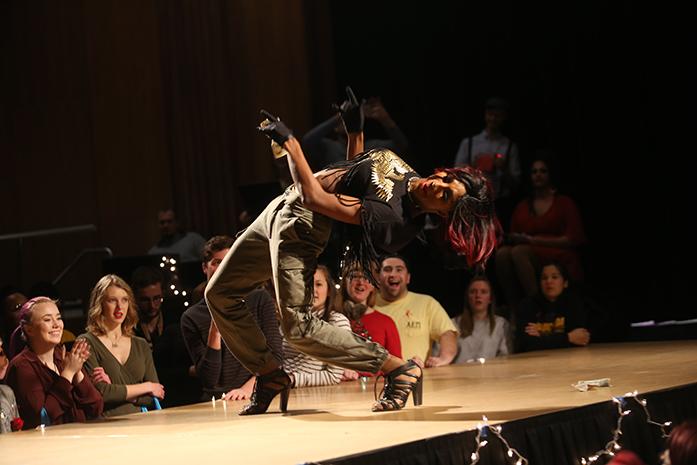A few UI students début their first performances in drag.
By Brett Shaw
Putting on heels, hair, and makeup to appear as a convincing woman is something that many females don’t think twice about. However, for some men, this becomes an intricate art form celebrated by the LGBTQ community.
Students at the University of Iowa have been given numerous opportunities to explore this art form because the community has provided stages for amateur drag performers.
One event on Dec. 2 was the annual Mirage in the IMU, which featured an amateur drag queen and king competition. UI students who have limited experience with drag took the stage and lip-synched for the crown.
The winner of the Mirage competition, whose drag name is “Queen Fantasia Wood,” stunned the audience with her stunt-filled performance of a Kim Possible/That So Raven theme song mash-up. Wood said she has done drag for four months and was inspired after her frequent visits to shows at local alternative bar Studio 13, 13 S. Linn St.
“I think that [drag] is important in terms of being able to show the diversity of gender and being able to exist outside of the binary,” Wood said. “They are also a good way to bring the community together, because drag queens often attract the crowds to gay bars.”
Another event that occurs more frequently in Iowa City is Studio 13’s Drag U program, which takes place each Wednesday when in season. The program prepares men for their first-ever drag performances with the mentoring of resident queens. The most recent performance featured UI student Joe Reed.
To prepare for his performance, he first had to get his wardrobe together, learn how to walk in heels, practice his dance number, and even go bra shopping so he could transform into “Josephine.”
A large appeal of performing drag is the confidence and power that it instills in those who perform.
“If I looked at myself four years ago, I never ever thought I would have done this,” Reed said. “When all of your friends are standing there and cheering for you, it makes you feel like a star.”
He hopes to continue performing drag in the future because of how much he enjoyed the experience. Some drag queens turn their art into a career, including Myling Belle, the show director at Studio 13 and Drag U originator.
“Every time you step out there on stage and you get that overwhelming response of people singing along with you or are mesmerized with your outfits or hair, that’s what truly makes me happy,” Belle said.
Belle said becoming a professional drag queen requires an extreme amount of practice and commitment to perfect the artistic illusion; she had her start as a first-time drag performer in an office charity show.
“I always am looking forward to new talent and how I can help as a queen who has been doing this for a while,” Belle said. “The best thing we can do is to nurture the new talent and help them become better queens.”
Impersonating genders for entertainment has been around for many years and has gone through many transformations to what drag is today. Jill Davis, a UI visiting assistant professor of gender, women’s and sexuality studies and drag-king performer, has thoroughly studied the anthropology of drag performance.
She said drag can be traced to many different origins, but modern drag associated with the LGBTQ community can be found in variety shows at the turn of the 20th century. Female and male impersonators performed in taverns not associated with any particular sexuality.
“People started to coalesce around public spaces, organize around same-sex sexual behavior,” Davis said. “Ideas of sexuality and gender were really closely linked, so these spaces became associated with the performance of female impersonators.”



